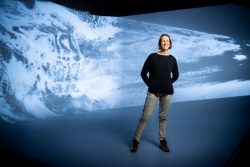

Sandia National Laboratories statistician Lyndsay Shand stands in front of a satellite image of ship tracks. Ship tracks are an unintentional example of one method to reflect some sunlight back to space before its heat is absorbed. (Photo by Craig Fritz) Click on the thumbnail for a high-resolution image.
To understand how these ship tracks move and dissipate, the scientists created a mathematical model of ship tracks and how long they last, which they shared in a paper recently published in the scientific journal Environmental Data Science.
"Ship exhaust is an example of aerosol injections into the lower atmosphere, impacting the local environment, and is a daily occurrence," said Lyndsay Shand, a Sandia statistician and the project lead. "We've been developing analytical tools to understand exhaust impacts on clouds from observational data collected by satellites. For example, we can locate a newly formed ship track and follow its evolution to better understand how it affects the local marine environment over time. We have found ship tracks to persist for more than 24 hours, longer than previously documented."
Forming ocean clouds to slow climate change
Ship tracks are an unintentional example of marine cloud brightening, a group of technologies being considered for slowing climate change and its impacts. Marine cloud brightening works by creating ocean clouds that reflect some sunlight back to space before its heat is absorbed in the atmosphere or by Earth's surface.







